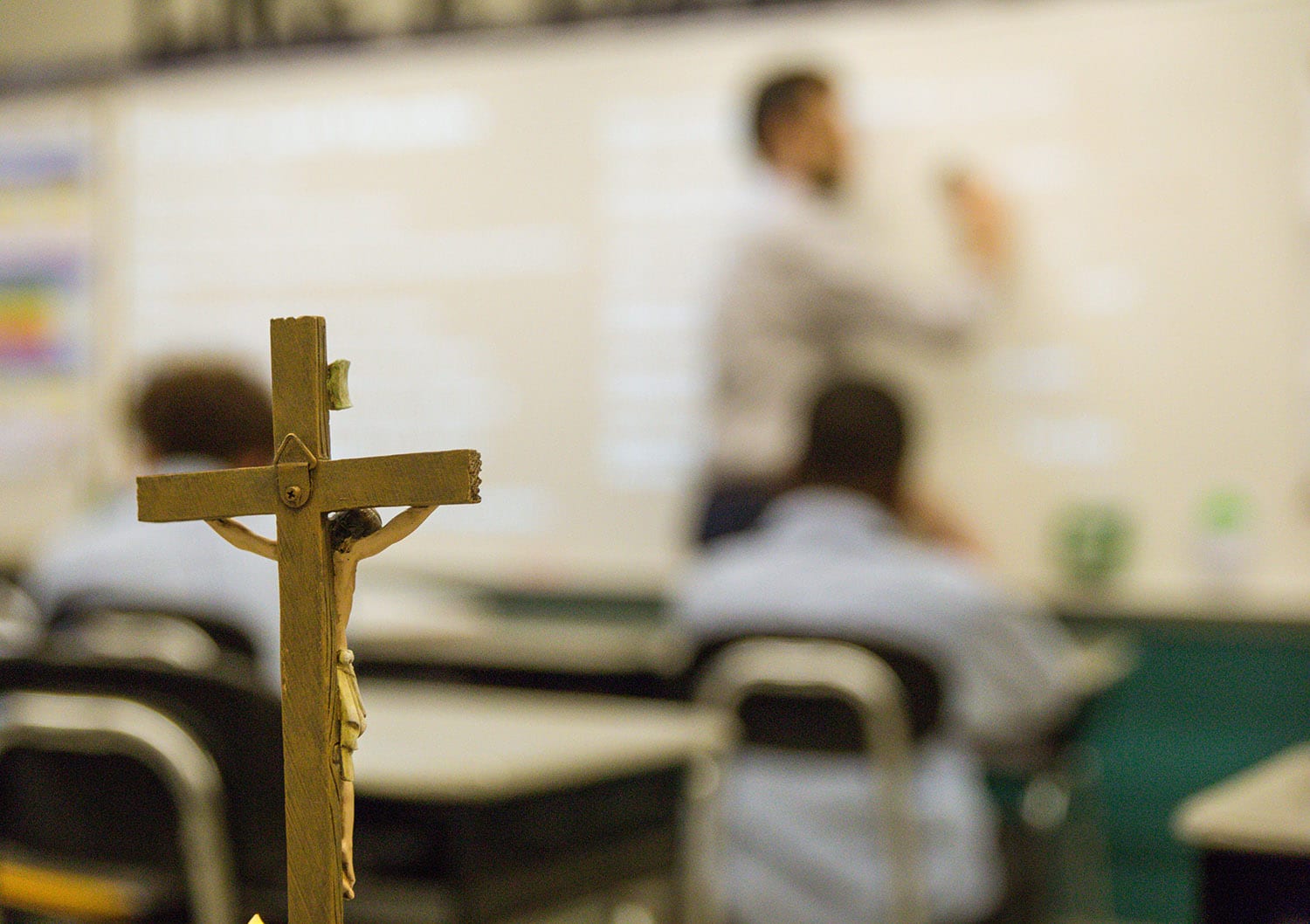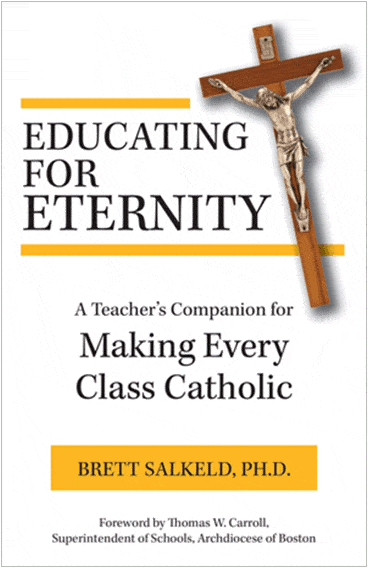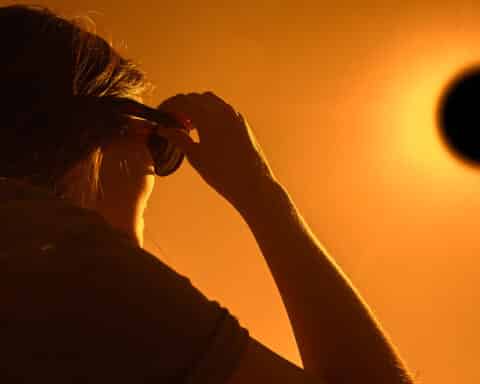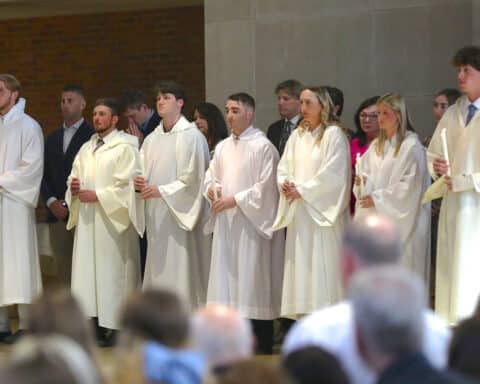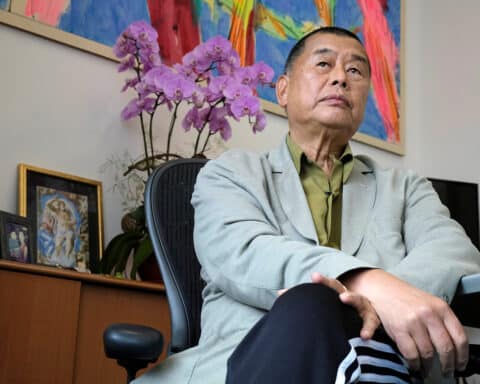As a Catholic school principal, prospective families often ask me about the Catholic identity of the school. My initial reaction is often to name the distinctly Catholic practices that we engage in — weekly Mass, regular confessions, school-wide Rosaries, Eucharistic processions, etc. And celebrating the sacraments and engaging with the Faith in these tangible ways should all be regular features of an authentic Catholic education. After all, these things are important, not just in building and promoting the school’s Catholic identity, but more importantly in shaping the hearts, minds and souls of our students.
Yet, as Brett Salkeld rightly suggests in his new work, “Educating for Eternity: A Teacher’s Companion for Making Every Class Catholic” (OSV, $12.95), these tangible manifestations of a school’s Catholic identity should not be the only way in which a Catholic school lives out its mission. According to Salkeld, what makes a Catholic education truly Catholic is “the way in which a Catholic worldview informs academic instruction in every subject area.”
At first glance, this may sound like suggesting if we just “sprinkle in” some Catholicity in each subject area — mention a few Catholic scientists in chemistry class or teach a lesson on Catholic historical figures in social studies — the school will become more authentically Catholic; however, Salkeld is quick to dismiss this surface-level approach. Instead, he calls Catholic educators to a much higher standard. “We need to teach not merely Catholic content,” he writes, “but teach from within a Catholic context for making sense of all life and learning.” That is to say that schools who truly live their Catholic mission approach all of education from a distinctly Christian anthropology, “built upon the premise that people are for God.”
Christian anthropology
Working from this principle, Salkeld then utilizes Part I of “Educating for Eternity” to outline the essential tenets of this Christian anthropology in relation to the Catholic classroom. Specifically, Salkeld delves into what it means to “educate the whole person” within a Catholic school setting. While this phrase has perhaps become so overused that it has lost its meaning, Salkeld does well to parse out what “educating the whole person” truly entails. Unlike the utilitarian approach common in secular schools, Catholic schools seek to develop the whole person by purposefully assisting students in their lifelong search for joy and quest for truth — two concepts that are closely linked.
Regarding joy, Salkeld writes that “a Catholic education seeks to form a student into someone who can live well … because becoming who God calls us to be is where eternity touches this world right now.” In other words, when we become who God calls us to be, when we become holy, then our search for authentic joy reaches its fulfillment. Yet, this does not just occur miraculously. It is the role of Catholic schools, Salkeld asserts, to instruct students in the practices of a truly “good life” that will ultimately lead them to joy.
| A teacher’s companion |
|---|
|
In “Educating for Eternity: A Teacher’s Companion for Making Every Class Catholic,” Brett Salkeld, Ph.D., explains the role of Catholic anthropology in education and accompanies Catholic teachers in integrating the Faith into all aspects of the curriculum. From math and science to health and social studies, every subject can and should be taught from a Catholic worldview. And in doing so the true purpose of Catholic education is fulfilled. Purchase your copy at OSVCatholicBookstore.com. |
Similarly, Salkeld notes, it is the role of Catholic educators to guide students in their quest for truth and, in that truth, freedom. The first step in this process is to acknowledge that there is truth at all. This is particularly noteworthy in our current culture in which students often think that “everything is up for grabs and no real answers exist” and as a result, “all they can really strive for is to learn some technical skills that will give them a decent salary so they can afford a few creature comforts.” Recent educational trends certainly bear this out, with an emphasis on “teaching students how to think, not what to think.” This is demonstrated, for example, by “common core” standards that lack specific content recommendations but list innumerable “critical thinking” skills students must develop. Where this misses the mark, as Salkeld rightfully notes, is that before students can think critically, they must first be provided with content to think critically about. And what this content is matters. Not insomuch as it all must be distinctly Catholic, but that it must be rooted and framed in a truth that “satisfies the human heart,” as Salkeld writes. A truth that is good and beautiful. A truth ultimately lived out by the person of Jesus Christ.
Personal formation for Catholic educators
Having presented a detailed sketch of Christian anthropology and its main touchpoints with Catholic education, Salkeld utilizes Part II of his work as a more concrete exploration of how this anthropology impacts eight specific subject areas. Yet if, as Salkeld suggests, this book is “first and foremost a professional development resource for Catholic teachers,” I would suggest that Part I is perhaps the more essential read for all Catholic educators.
In my own anecdotal experience as a Catholic school principal who is frequently tasked with hiring new teachers, many candidates can identify the actions that make up a school’s Catholic identity — things like attending Mass or praying to start class and before meals. Yet, few can articulate what it means to have a Catholic worldview and, more importantly, detail the ways in which this worldview should shape instruction in the classroom. Most often this is because they do not have a strong understanding of what this worldview entails. Or, perhaps more alarmingly, they have not been convinced of its truth. You cannot give what you do not possess. These educators, then, would benefit most from delving deeply into the content of Part I. Without doing so, Part II would merely serve as a superficial solution to a deep-seated problem.
After all, if one comes to understand, truly and deeply, a Christian anthropology, and in turn lives out a distinctly Catholic worldview in his or her own life, the ideas and concepts included in the subject-specific guide in Part II will come almost naturally. Indeed, Salkeld acknowledges this at the start of Part II, writing that, “when seeking to teach from a Catholic point of view, there is no substitute for being steeped in that worldview yourself. And so, the most important prerequisite for teaching all subjects from a Catholic point of view is to take interest in our own intellectual (as well as spiritual!) formation as Catholics.”
Now, this is not to say that Part II of “Educating for Eternity” is not without merit. It is certainly still worth a careful read, even if it is at times short on specifics. Also, “the subject-specific chapters can, despite occasional references to previous chapters, be read in any order,” meaning teachers are free to skip around to the sections that apply most to their content areas.
Educating students for heaven
As a literature and history teacher prior to taking on an administrative role, I jumped to these sections first and found them insightful though occasionally lacking in practical advice.
The section on literature focuses largely on the essential role language plays in our faith and, as Salkeld writes, “any worldview that takes language this seriously is bound to produce great literature.” He goes on to outline connections between language and creation and the Incarnation, which, while sound in principle, may not be the specific, practical wisdom some teachers are seeking, particularly teachers of elementary or middle school students who would find these ideas difficult to grasp.
In the section on history, Salkeld does provide some helpful, specific touchpoints for adding Catholic content to history courses, including the roles of potentially lesser-known figures, from Kateri Tekakwitha and Paul Miki to Charles Lwanga and Mark Ti Jianxiang. In addition, Salkeld’s repeated emphasis that “the Bible’s vision of a transcendent God makes history as we understand it — open-ended, responsive to genuine freedom — possible” is a simple, strong foundation for teaching history from a Catholic worldview and is worth pondering for any Catholic history teacher. Unfortunately, he spends much of the remainder of the chapter dispelling common historical myths relating to Catholicism and religion at large (i.e. the myth of religious violence, religion as a tool to oppress the masses, etc.), which, for those educators interested, may be better explored through more complete works on these topics.
Overall, “Educating for Eternity” provides much-needed insight into the challenges faced in the world of Catholic education today. If we truly want to educate our students for heaven, we must do more than sprinkle in Catholic content when convenient. Catholic educators must, first and foremost, adopt a Catholic worldview themselves, a uniquely Christian anthropology “built upon the premise that people are for God.” It is only when Catholic educators are steeped in this worldview personally that it will permeate not only the selection of content in their classrooms, but also the way in which they guide students in thinking about and engaging with this content. Salkeld gets this right, and his work is an excellent starting point for all Catholic educators seeking to deepen their understanding of how our faith calls us to view the world around us with an eye, always, on eternity.

